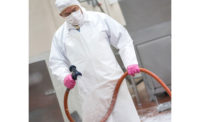
|
Inspection and detection systems encompass equipment ranging from X-ray machines to metal detectors and fat-analysis detectors. The meat industry, for one, has been using metal detectors on production and packaging lines for decades to remove foreign objects from materials.
“From a worker-safety standpoint, these inspection and detection systems are of minimal concern,” says Dan McCausland, senior director of worker safety and human resources, American Meat Institute (AMI), based in Washington, D.C. “The levels of radiation are quite low, and normally well-contained so as not to expose workers.”
Typically, McCausland says, metal and fat analysis detectors are constructed so that workers are not exposed to the active detection field.
“These [fat analysis systems] are typically not on-line systems, but are sampling-based and done in small lab rooms adjacent to production,” he says. “These are very common for beef and pork trimmings, which are priced on a lean/fat ratio basis.”
According to Justin Ransom, Ph.D., assistant vice president of food protection and government affairs, OSI Group LLC, based in Aurora, Ill., the multiple systems his company uses to detect foreign objects and/or determine fat content utilize different technologies, including X-ray, magnets and infrared spectrometry.
“In all cases, the detection equipment technology meets federal guidelines for worker safety,” says Ransom. “Due to the extensive control systems in the detection equipment, it does not present any danger to employees. Specific training is based on the job function, which includes operating equipment in a safe manner.”
In fact, the training process for inspection and detection systems is more likely to focus on accuracy rather than safety now, since employees generally do not stand right next to the machines, says Donna Schaffner, associate director of food safety, quality assurance and training, Rutgers Food Innovation Center, based in Bridgeton, N.J.
“Now that technology has changed so that food goes through the machine and a computer examines it, there is not the danger to employees of being constantly exposed to radiation,” she says. “However, plant managers need to check on an annual basis that there is no radiation leakage from these machines. Preventative maintenance is important and can be overlooked.”
The biggest cause of employee injuries, according to Schaffner, is if an employee disables safety features on the equipment so the system runs faster and the plant can — misguidedly— save time by not dealing with a safety shut down, if one were supposed to occur. Also, if machines have lasers or UV light, employees will need to be properly shielded.
“It’s common to see placards up that notify workers not to look at them or they will receive burns and injuries,” she says.
In addition, companies must have an employee safety program in place so employees follow the correct procedures, for example, as to when to put on and take off their shields.
“It all comes back to training and oversight specific to that piece of equipment, and as part of the overall safety-training program,” she says.
Safety first
Operation of X-ray machines is limited to persons instructed in safe operating procedures, says McCausland, who are competent in the correct use of the apparatus.
In order to assist a plant in meeting and understanding the various requirements of the radiation protection regulations, says McCausland, a state may require a company to post at the plant: a “Notice to Employees” sign that informs employees about standards adopted by the state to protect employees from hazards associated with radiating emission machines; and/or a Certificate of Registration showing that the company is in compliance with proper registration requirements.
“Recommended practices and policies for radiation safety for industrial radiation machines also will be reviewed and adopted as necessary upon registration of a machine,” says McCausland. “All registrants are subject to periodic review by the appropriate state oversight department.”
At OSI, employees receive general training on the X-ray system in the work environment, particularly focusing on their safety regardless of proximity.
“For those employees who are responsible for the equipment working properly, specific to food matrices or specification, the depth of training is more technical and worker-safety training is included,” notes Ransom.
Because OSI’s detection systems are contained in stainless-steel cabinets, and the X-rays are generated electronically and do not create any radioactivity, the company doesn’t have to establish a control zone around the machine, he says. Also, OSI is not required to appoint a specific employee to use the equipment, Ransom says.
“For reasons specific to ensuring the equipment is working properly, and at the correct setting for specific products, specialized employees receive extensive training on the machines, which includes but is not limited to worker safety,” says Ransom.
Rutgers has created a variety of training programs for employers, such as a short program in which the supervisor spends a half hour with an employee or weeks depending on how complicated the equipment is.
“It requires a great deal of finesse to run products through the metal detectors,” Schaffner notes.
For a new training program, Schaffner would first examine the manufacturer’s equipment manual and adapt it to an employee-training program, including the manufacturer’s recommendations for how to safely operate the machine. Then, the manufacturer is invited to perform an initial and refresher training course for employees.
“Food safety is a more comprehensive training program, and we bring in outside help for specific groups to incorporate food safety with equipment training,” says Schaffner. “More hands-on training is better than an annual one-hour lecture.”
Continual development of training matrices specific to job functions is essential for worker safety in any industrial environment, notes Ransom. With advanced training systems, companies can more efficiently train their employees, determine their comprehension of training materials, and follow up with specified or individual training to ensure that high standards for worker safety and Good Manufacturing Practices are being met.
“Employee training, worker-safety monitoring and accountability through measureable objectives is critical to continuous improvement in worker safety — you can’t improve what you don’t measure,” says Ransom.
Following the rules
At the federal level, the Occupational Safety and Health Administration (OSHA) does have standards for both ionizing (radioactivity) and non-ionizing (electromagnetic and radio frequency) radiation applications, McCausland says. These would apply in any situation where workers were exposed to either form of radiation.
“For example, meat plants making pre-cooked bacon with industrial microwave ovens would fall under the non-ionizing rule due to the use of microwave radio frequency cooking,” says McCausland. “However, there is typically little or no actual exposure to workers from modern flow-through microwave ovens.”
In one instance, he notes, when a company registers an X-ray machine for a plant with a state emergency management agency, there is some initial training that includes the use of radiation exposure badges for employees.
“I have yet to hear about badges picking up any radiation exposure to employees, and normally the company would not be required to do any additional sampling,” he says.
It can be easy for companies to lose track of their employee-training programs, if they don’t have Hazard Analysis & Critical Control Points (HACCP) procedures to maintain their annual program, says Schaffner. However, keeping up with employee training and stocking safety materials, such as cut-resistant gloves, will improve working conditions.
It was just 20 years ago that processing plants had a far higher number of workplace accidents, says Schaffner, but now accidents are much more rare and there is a greater emphasis on employee safety from equipment manufacturers to processing plant owners.
“There is much more employee awareness and they don’t accept dangerous conditions,” she says, adding that employers are conscious of complying with regulations and reducing their liability and insurance costs.
“Employers can’t afford not to provide training because of liability concerns,” she says.










